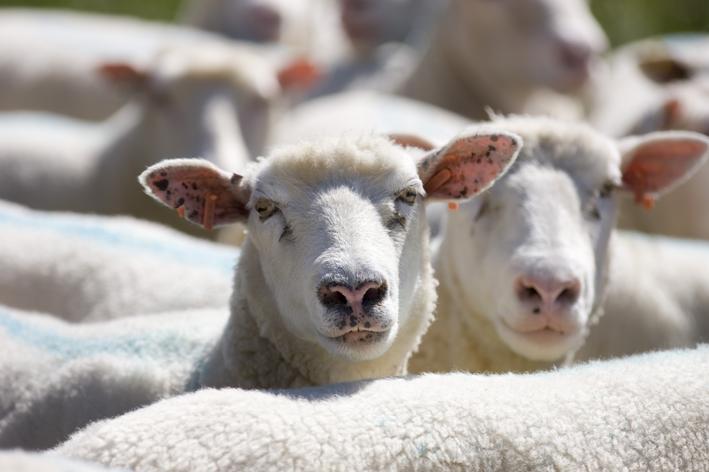New vaccine hopes for endemic sheep disease
Published on 18 April 2011 in Sustainability and Communities , Food, health and wellbeing
Introduction
 Since its introduction into the UK over two decades ago, caseous lymphadenitis (CLA) has become endemic within the national sheep flock. CLA is a chronic bacterial disease of sheep and goats. Infection leads to the formation of abscesses in the lymph nodes around the head but also abscesses in internal organs (including the lungs) which can lead to respiratory distress and chronic weight loss.
Since its introduction into the UK over two decades ago, caseous lymphadenitis (CLA) has become endemic within the national sheep flock. CLA is a chronic bacterial disease of sheep and goats. Infection leads to the formation of abscesses in the lymph nodes around the head but also abscesses in internal organs (including the lungs) which can lead to respiratory distress and chronic weight loss.
Options for controlling the spread of the disease are limited, although diagnosis (and culling of infected animals) and/or vaccination are the preferred approaches. No fully-licensed CLA vaccine is available in the UK, but permission may be granted by the Veterinary Medicines Directorate for restricted use of an imported CLA vaccine.
However, this vaccine complicates the use of a Scottish commercial CLA diagnostic blood test , since vaccinated animals produce identical antibodies to those found in infected animals, and the diagnostic test detects these antibodies, but cannot distinguish between those from vaccinated or infected animals. Therefore, to allow concurrent use of vaccination and test and cull approaches for disease control, there is a need for an effective new vaccine that does not interfere with blood test results.
Key Points
Based on observations of the impact of CLA in other countries, the Moredun Research Institute and Scottish Agricultural College (SAC) predicted an increasing problem for UK producers and initiated research directed towards developing tools to allow producers to combat CLA. This work has been supported throughout by the Scottish Government and Red Meat Levy Boards, especially Quality Meat Scotland, and allowed the development of a CLA blood test which is currently the basis of a testing service provided by SAC .
 Research at Moredun has been undertaken to study the means by which the bacterium responsible for CLA, Corynebacterium pseudotubercuosis, causes disease in sheep (and by analogy goats). It is well-recognised that different types of bacteria produce a range of distinct types of proteins to help them colonise different environments. By ‘sensing’ their environment they are better-able to conserve energy and nutrients, by producing only those proteins which are required for survival in their immediate surroundings. Of relevance to CLA vaccine development has been the identification of proteins that the CLA-causing bacterium produces during infection of sheep.
Research at Moredun has been undertaken to study the means by which the bacterium responsible for CLA, Corynebacterium pseudotubercuosis, causes disease in sheep (and by analogy goats). It is well-recognised that different types of bacteria produce a range of distinct types of proteins to help them colonise different environments. By ‘sensing’ their environment they are better-able to conserve energy and nutrients, by producing only those proteins which are required for survival in their immediate surroundings. Of relevance to CLA vaccine development has been the identification of proteins that the CLA-causing bacterium produces during infection of sheep.
Armed with a greater understanding of how infection occurs, combined with the availability of state-of-the-art research facilities within the Institute, significant progress has been made towards the development of novel experimental vaccine formulations. Further advances at Moredun in the genetic manipulation of C. pseudotuberculosis now allow the creation of vaccine strains, designed specifically to maximise efficacy whilst addressing the issue of non-interference with the available CLA blood test. Significantly, this approach has recently received financial support through the Scottish Enterprise Proof of Concept Scheme , allowing the commercial development of a product designed primarily for UK producers.
Research Undertaken
Using the newly-available genetic manipulation technique a derivative of the CLA-causing organism has been produced. This vaccine strain has been modified into ‘thinking’ it is within an animal, even when cultivated under artificial laboratory conditions. Consequently, the strain routinely produces a variety of proteins that are normally only produced during infection, and the modified bacterium has been used as a means of producing an enriched CLA vaccine.
It is anticipated that immunisation of sheep with this vaccine will enhance the ability of animals’ immune systems to fight off infection at the point that the bacterium tries to become established. Furthermore, the vaccine strain has been engineered not to produce certain proteins that animals would normally be exposed to during a natural C. pseudotuberculosis infection. Therefore, the absence of an immune response (and hence production of antibodies) against these proteins can be used as the basis for Differentiating Infected from Vaccinated Animals (DIVA), and the currently-available CLA blood test can be used to make this differentiation.
Policy Implications
While rising global population is expected to increase demand for livestock products, predictions of climate change suggest that some geographic areas, where animals are current intensively-reared, will be less able to sustain this practice in the future. Therefore, the issue of food security has come to the attention of governments worldwide. Significantly, animal disease is one of the major factors affecting livestock productivity. In Scotland, agriculture is a major contributor to the national economy, and the sheep industry is an essential component of many rural communities. Consequently, work towards minimising the impact of animal disease will impact positively upon Scotland’s productivity and success.
Author
Dr Michael Fontaine michael.fontaine@moredun.ac.uk
Topics
Sustainability and Communities , Food, health and wellbeing







